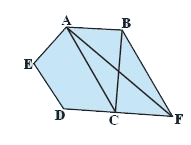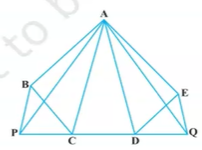In the figure, ABCDE is a pentagon. A line through B parallel to AC meets DC produced at F. Show that
(i) ar(ΔACB)=ar(ΔACF)
(ii) ar(AEDF)=ar(ABCDE)
 Solution in Telugu
Solution in Telugu
Step by step video & image solution for In the figure, ABCDE is a pentagon. A line through B parallel to AC meets DC produced at F. Show that (i) ar (DeltaACB) = ar (DeltaACF) (ii) ar (AEDF) = ar (ABCDE) by Maths experts to help you in doubts & scoring excellent marks in Class 9 exams.
Updated on:21/07/2023Topper's Solved these Questions
Similar Questions
If E, F G and H are respectively the midpoints of the sides AB, BC, CD and AD of a parallelogram ABCD, show that ar(EFGH) =12 ar (ABCD) .

View SolutionConstruct a circumcircle of the triangle ABC where AB = 5cm, ∠B=75∘ and BC = 7 cm.
View SolutionIn figure, ABCDE is any pentagon. BP drawn parallel to AC meets DC produced at P and EQ drawn parallel to AD meets CD produced at Q. Prove that ar(ABCDE)=ar(ΔAPQ).

View Solutionआकृति में ABCDE एक पंचभुज है । B से होकर AC के समांतर खींची गई रेखा बढ़ाई गई DC को F पर मिलती है दर्शाइए कि
(i)ar(ACB)=ar(ACF)
(ii)ar=(AEDF)=ar(ABCDF)

View SolutionIn the adjoining figure, ABCD is a quadrilateral. A line through D, parallel to AC, meets BC produced in P .
Prove that ar(△ABP)=ar(qaud. ABCD).

View Solutionचित्र में , ABCD एक समान्तर चतुर्भुज है तथा EFCD एक आयत है। साथ ही AL⊥DC, तो सिद्ध कीजिए कि
(i)ar(ABCD)=ar(EFCD)
(ii)ar(ABCD)=DC×AL
View Solutionदिए गए आकृति में ABCDE एक पंचभुज है| B से होकर AC के समांतर खींची गई रेखा बढ़ाई गई DC से F पर मिलती है |दर्शाइए की
(1)ar(ACB)=ar(ACF)
(ii)ar(AEDF)=ar((ABCDE)
(##KCSHINMATIXC11SLV029_Q01##)
View SolutionIn, ABCDE is a pentagon. A line through B parallel to AC meets DC produced at F. Show that
(i)ar (ACB) = ar (ACF)
(ii)ar (AEDF) = ar(ABCDE)

View SolutionIn the figure, ABCDE is a pentagon. A line through B parallel to AC meets DC produced at F. Show that
(i) ar (ACB) = ar (ACF)
(ii) ar (AEDF) = ar (ABCDE)
View SolutionIn the figure, ABCDE is a pentagon. A line through B parallel to AC meets DC produced at F. Show that (i) ar (DeltaACB) = ar (DeltaACF) (ii) ar (AEDF) = ar (ABCDE)
View SolutionIn the figure, ABCDE is a pentagon. A line through B parallel to AC meets DC produced at F. Show that
(i) ar(ΔACB)=ar(ΔACF)
(ii) ar(AEDF)=ar(ABCDE)

View SolutionIn figure, ABCDE is any pentagon. BP drawn parallel to AC meets DC produced at P and EQ drawn parallel to AD meets CD produced at Q. Prove that ar(ABCDE)=ar(ΔAPQ).

View Solutionਚਿੱਤਰ 9.27 ਵਿੱਚ ,ABCDE ਇਕ ਪੰਜਭੁਜੀ ਹੈ। B ਵਿਚੋਂ ਲੰਘਦੀ, AC ਦੇ ਸਮਾਂਤਰ ਖਿੱਚੀ ਗਈ ਰੇਖਾ, ਵਧਾਈ ਹੋਈ DC ਨੂੰ F 'ਤੇ ਮਿਲਦੀ ਹੈ। ਦਰਸਾਓ ਕਿ:- (i) ar (ACB) = ar (ACF) (ii) ar (AEDF) = ar (ABCDE)

View SolutionIn Fig. 9.27, ABCDE is a pentagon. A line through B parallel to AC meets DC produced at F. Show that:- (i) ar (ACB) = ar (ACF) (ii) ar (AEDF) = ar (ABCDE)

View SolutionIn the figure, ABCDE is a pentagon. A line through B parallel to AC meets DC produced at F. Show that ar( Delta AEDF) = ar( Delta ABCDE)
View Solution
